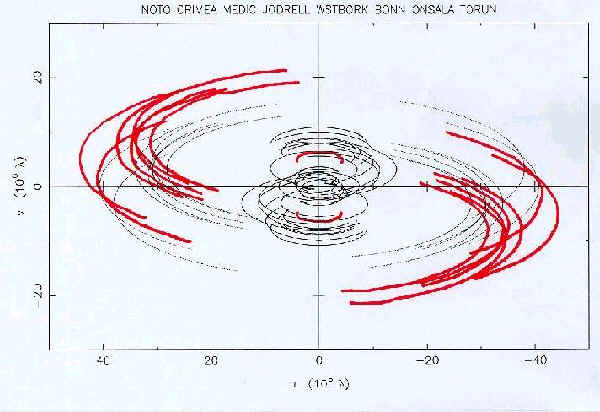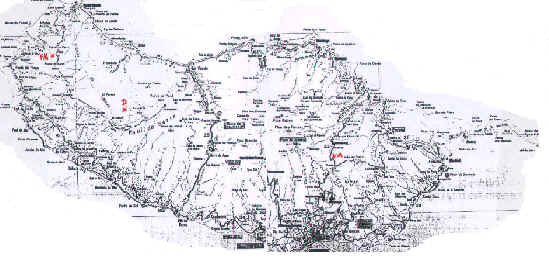
fig 1
|
UNIVERSIDADE DA MADEIRA |
|
GRUPO DE ASTRONOMIA |
Prospects
for a new VLBI antenna
at the island of Madeira
Pedro Augusto,1 Roy S. Booth,2 Richard J. Davis,3 and Gavril Grueff,4
1Universidade
da Madeira,
Departamento de Matemática,
Caminho da Penteada, 9000 Funchal, Portugal
2Onsala
Space Observatory, 43992 Onsala, Sweden
3University
of Manchester, Jodrell Bank Observatory, Macclesfield,
Cheshire SK11 9DL, UK
4Istituto
di Radio Astronomia/CNR, Via Gobetti 100, I-40100 Bologna, Italy
ABSTRACT
|
A telescope at the island of Madeira (Portugal) is a great opportunity to dramatically increase the quality of Very Long Baseline Interferometry (VLBI) observations, those of the European VLBI Network, in particular. It would allow the closing of an old infamous 'mid-Atlantic gap' that exists in current VLBI observations. We have selected three good sites for more detailed local studies. In one of these a new radio telescope will be built. |
|
MADEIRA Not far off the african coast (Morocco), the island of Madeira enjoys a mild subtropical climate at the sea level. In the highest peaks (about 1800 m) mild storms and some snow are common in the Winter. Between these and the sea, a range of climats and micro-climats exists due to the large number of steep and narrow valleys at all altitudes. |
|
WHERE TO BUILD THE ANTENNA? To decide which of the three sites is the best to build the new radio telescope at Madeira, we must conduct detailed studies at each: meteorological data during, at least, a full year (due to begin before the end of this year); radio interference measurements for a few weeks (early next year?); soil and ground surveys; 360º horizon profiles. Finally, column water measurements should be cheaply available for all sites from the MODIS instrument in the TERRA mission of NASA. |
|
CURRENT PLANS FOR THE ANTENNA
|
|
THE CASE FOR A NEW ANTENNA AT MADEIRA 1) SENSITIVITY VLBI – A radio telescope in the Atlantic has been an old ambition of radio astronomy, since this would reduce the infamous ‘mid-atlantic gap’ seen in the u-v plane coverage of global Very Long Baseline Interferometry (VLBI) observations. In the Figure 1 we present the effect of adding an antenna at Madeira (red) during global VLBI observations of a source at a declination of 60º, using ten European VLBI Network (EVN) and three US antennas. EVN – Currently, this interferometer, excluding the two chinese antennas, includes eight antennas, making N(N-1)/2 baselines, i.e., 28, since N=8. With another station at Madeira, N=9 gives 36 baselines, a 30% increase in sensitivity. The effect can be seen (red) in the Figure 2, which simulated such observations of a source at a declination of 20º. 2) RESOLUTION The current maximum baseline length of the European VLBI Network (EVN) is 2800 km (european antennas only). This would be increased by 10% with a telescope at Madeira (3100 km). The Figure 2 shows this effect (red). |

fig 1

fig 2
|
THE THREE SITES The ideal site to build a radio telescope is not necessarily a high mountain site but rather a shallow valley protected from city/man made interference. It should not be exposed to frequent gusty/very strong winds. Seven sites (A-G) were initially selected for on-site inspection, of which only three (A, D and F/G) were left for further study. These sites are shown on Figure 3 and desbribed as follows: A) 16º52’45”W, 32º43’35”N, alt: 1150 m; good site; mountains (S) block Funchal, although the site is close to the city; D) 17º07’20”W, 32º46’15”N, alt: 1300 m; good site; shallow deep; difficult road access, easy to improve; far from Funchal; F/G) 17º11’20-40”, 32º48’45”-49’00”, alt: 1015-1100 m; area full of potentially good sites; easy road access; far from Funchal. |

fig 3
|
ACKNOWLEDGEMENTS We warmly acknowledge the former Head of the University of Madeira (Dr José Castanheira da Costa) for constant encouragement, interest and making all the oficial contacts available – crucial to start any project as big as this. Our equally warm thanks to all ~70 astronomers from 16 countries that signed a document supporting the construction of the new telescope. We further acknowledge the following institutions for use of their data, tutorials, further contact lists or simply support: Joint Institute for VLBI in Europe (Holland), Istituto di Radio Astronomia – Medicina station (Italy), Jodrell Bank Observatory (Univ. Manchester, UK), Instituto Nacional de Meteorologia e Geofísica – Madeira, Instituto Português de Cartografia – Madeira, Laboratório Regional de Engª Civil – Madeira. |